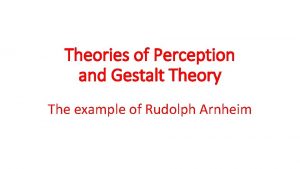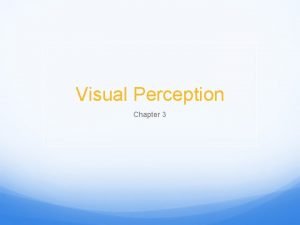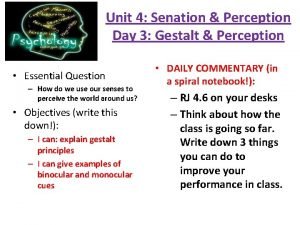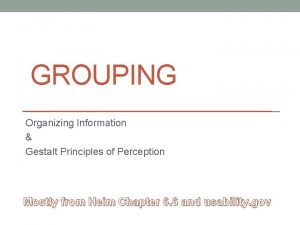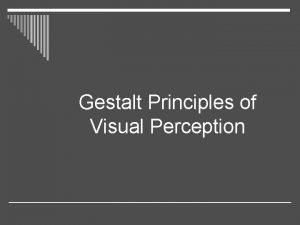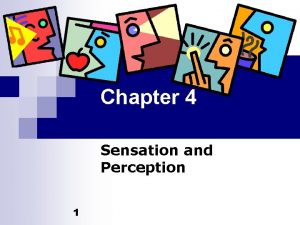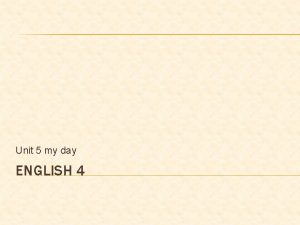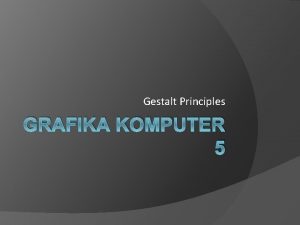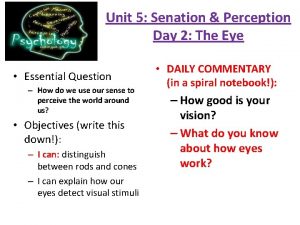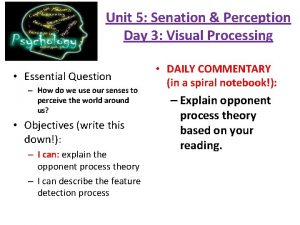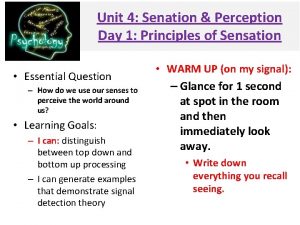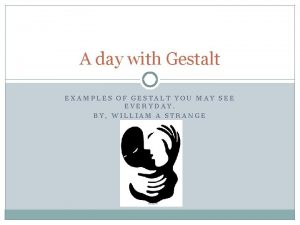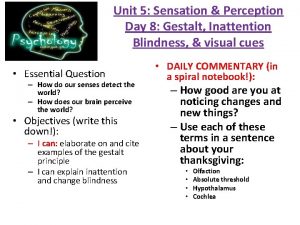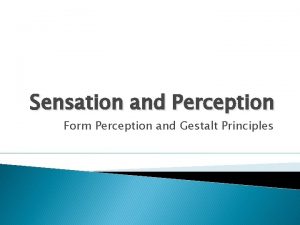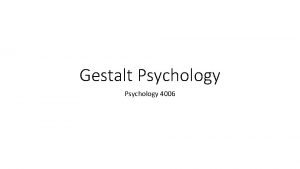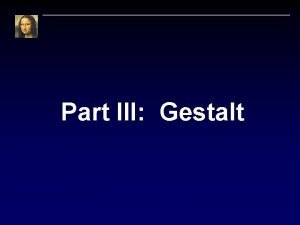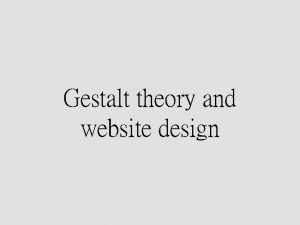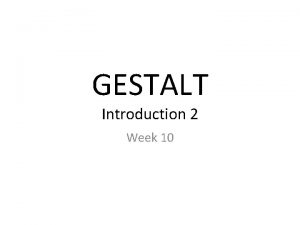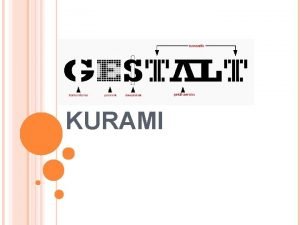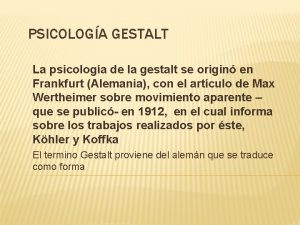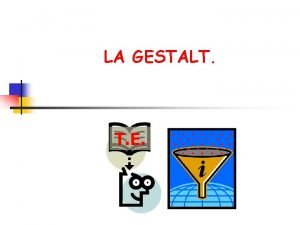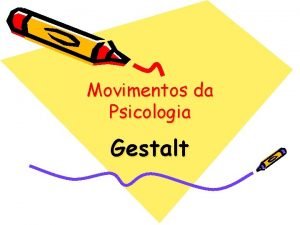Unit 4 Senation Perception Day 3 Gestalt Perception
























- Slides: 24

Unit 4: Senation & Perception Day 3: Gestalt & Perception • Essential Question – How do we use our senses to perceive the world around us? • Objectives (write this down!): – I can: explain gestalt principles – I can give examples of binocular and monocular cues • DAILY COMMENTARY (in a spiral notebook!): – RJ 4. 6 on your desks – Think about how the class is going so far. Write down 3 things you can do to improve your performance in class.

Unit 4: Senation & Perception Day 3: Gestalt & Perception • Today: – DC – Videos Clips – Notes & Discussion: • Gestalt • Binocular & Monocular cues – Discovering Psychology • DO NOT SLACK OFF ON: – INTERVIEW PROJECTS • For Tonight: – Myers 250 -253 – Myers 256 -261 – RJ 4. 7

Perception The process of selecting, organizing, and interpreting sensory information, which enables us to recognize meaningful objects and events. 3

Selective Attention Perceptions about objects change from moment to moment. We can perceive different forms of the Necker cube; however, we can only pay attention to one aspect of the object at a time. Necker Cube 4

Depth Perception Innervisions Depth perception enables us to judge distances. Gibson and Walk (1960) suggested that human infants (crawling age) have depth perception. Even newborn animals show depth perception. Visual Cliff 5

Perceptual Constancy Perceiving objects as unchanging even as illumination and retinal images change. Perceptual constancies include constancies of shape and size. Shape Constancy 6

Size Constancy Stable size perception amid changing size of the stimuli. Size Constancy 7

Size-Distance Relationship The distant monster (below, left) and the top red bar (below, right) appear bigger because of distance cues. Alan Choisnet/ The Image Bank From Shepard, 1990 8

Size-Distance Relationship Both girls in the room are of similar height. However, we perceive them to be of different heights as they stand in the two corners of the room. Both photos from S. Schwartzenberg/ The Exploratorium 9

Ames Room The Ames room is designed to demonstrate the sizedistance illusion. 10

Co ur tes y Ed wa rd A de lso n Lightness Constancy The color and brightness of square A and B are the same. 11

Grouping After distinguishing the figure from the ground, our perception needs to organize the figure into a meaningful form using grouping rules. 12

Grouping & Reality Although grouping principles usually help us construct reality, they may occasionally lead us astray. Both photos by Walter Wick. Reprinted from GAMES Magazine. . © 1983 PCS Games Limited Partnership 13

Depth Perception Innervisions Depth perception enables us to judge distances. Gibson and Walk (1960) suggested that human infants (crawling age) have depth perception. Even newborn animals show depth perception. Visual Cliff 14

Binocular Cues Retinal disparity: Images from the two eyes differ. Try looking at your two index fingers when pointing them towards each other half an inch apart and about 5 inches directly in front of your eyes. You will see a “finger sausage” as shown in the inset. 15

Binocular Cues Convergence: Neuromuscular cues. When two eyes move inward (towards the nose) to see near objects and outward (away from the nose) to see faraway objects. 16

Monocular Cues Relative Size: If two objects are similar in size, we perceive the one that casts a smaller retinal image to be farther away. 17

Monocular Cues Interposition: Objects that occlude (block) other objects tend to be perceived as closer. Rene Magritte, The Blank Signature, oil on canvas, National Gallery of Art, Washington. Collection of Mr. and Mrs. Paul Mellon. Photo by Richard Carafelli. 18

Monocular Cues Relative Clarity: Because light from distant objects passes through more light than closer objects, we perceive hazy objects to be farther away than those objects that appear sharp and clear. 19

Monocular Cues Texture Gradient: Indistinct (fine) texture signals an increasing distance. © Eric Lessing/ Art Resource, NY 20

Monocular Cues Relative Height: We perceive objects that are higher in our field of vision to be farther away than those that are lower. Image courtesy of Shaun P. Vecera, Ph. D. , adapted from stimuli that appered in Vecrera et al. , 2002 21

Monocular Cues Relative motion: Objects closer to a fixation point move faster and in opposing direction to those objects that are farther away from a fixation point, moving slower and in the same direction. 22

Monocular Cues Linear Perspective: Parallel lines, such as railroad tracks, appear to converge in the distance. The more the lines converge, the greater their perceived distance. © The New Yorker Collection, 2002, Jack Ziegler from cartoonbank. com. All rights reserved. 23

Monocular Cues Light and Shadow: Nearby objects reflect more light into our eyes than more distant objects. Given two identical objects, the dimmer one appears to be farther away. From “Perceiving Shape From Shading” by Vilayaur S. Ramachandran. © 1988 by Scientific American, Inc. All rights reserved. 24
 Day 1 day 2 day 3 day 4
Day 1 day 2 day 3 day 4 Gestalt in film
Gestalt in film Gestalt reversible figures
Gestalt reversible figures Perception gestalt principles
Perception gestalt principles Gestalt texture gradient
Gestalt texture gradient Perception gestalt principles
Perception gestalt principles Gestalt principles of visual perception
Gestalt principles of visual perception Perception gestalt principles
Perception gestalt principles Day 1 day 2 day 817
Day 1 day 2 day 817 Unit 6 review questions
Unit 6 review questions Family sis schoolmax
Family sis schoolmax Haiku and
Haiku and Day to day maintenance
Day to day maintenance Physical science chapter 6 review answers
Physical science chapter 6 review answers I don't know tomorrow
I don't know tomorrow Timeline of events in romeo and juliet
Timeline of events in romeo and juliet Growing day by day
Growing day by day Observation of seed germination day by day
Observation of seed germination day by day Germination conclusion
Germination conclusion Observation of plant growth day by day
Observation of plant growth day by day I live for jesus day after day
I live for jesus day after day Dying he saved me buried he carried
Dying he saved me buried he carried Day one day one noodle ss2
Day one day one noodle ss2 Afc futsal coaching course level 1
Afc futsal coaching course level 1 Unit 5 my day off
Unit 5 my day off

